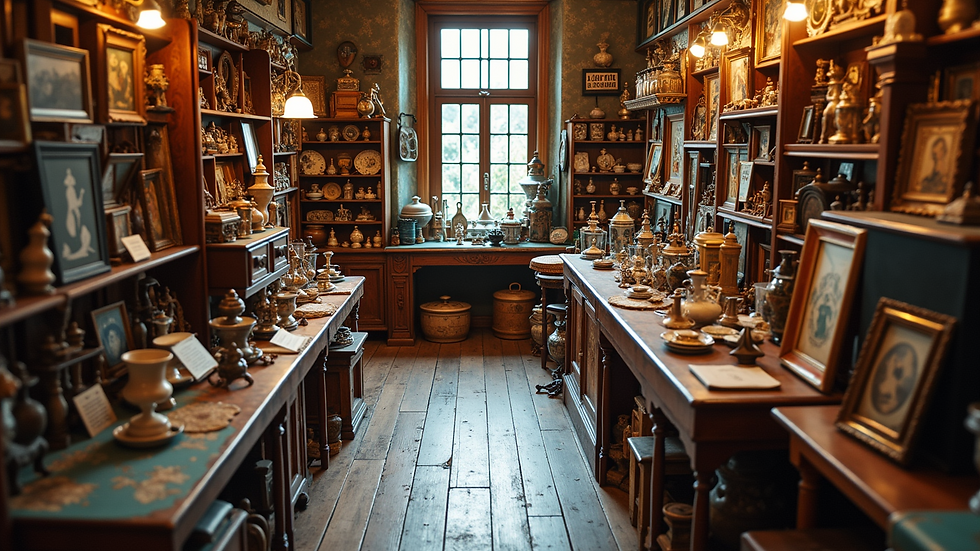Discover the Charm of Antique Collectibles
- The Time Traveller

- Sep 3
- 4 min read
Antique collectibles hold a special place in the hearts of many. They are more than just old objects; they are pieces of history, stories frozen in time, and treasures waiting to be discovered. Whether you are a seasoned collector or just starting, the world of vintage items offers endless fascination. This guide will help you explore the charm of these timeless pieces and provide practical tips to enhance your collecting journey.

Understanding the Vintage Collectibles Guide
Collecting vintage items is a rewarding hobby that combines passion, knowledge, and patience. Vintage collectibles typically refer to items that are at least 20 to 30 years old but not old enough to be classified as antiques (usually 100 years or more). These items can range from furniture, jewellery, and toys to clothing, books, and household goods.
The appeal of vintage collectibles lies in their uniqueness and the nostalgia they evoke. Each piece reflects the style, culture, and craftsmanship of its era. For example, a 1950s mid-century modern chair showcases sleek lines and innovative design, while a Victorian-era brooch tells a story of intricate artistry and elegance.
When starting your collection, consider the following tips:
Research: Learn about the periods and styles that interest you.
Condition: Check for wear and authenticity.
Provenance: Understand the item's history and origin.
Budget: Set a realistic spending limit.
Storage: Plan how to preserve your items properly.

How to Start Your Vintage Collectibles Guide
Beginning a collection can feel overwhelming, but breaking it down into manageable steps makes the process enjoyable. Start by identifying what excites you most. Are you drawn to vintage jewellery, classic toys, or antique furniture? Narrowing your focus helps you become an expert in a specific area.
Next, visit local markets, antique shops, and fairs. These places often have hidden gems waiting to be found. Online platforms also offer a vast selection, but be cautious and verify the seller’s credibility.
Keep a journal or digital record of your finds. Note details such as purchase price, condition, and any interesting facts. This habit not only tracks your collection but also increases your knowledge over time.
Networking with other collectors can be invaluable. Join clubs, attend auctions, or participate in online forums. Sharing experiences and advice enriches your collecting journey.

What Website Identifies Antiques?
Identifying antiques can be tricky, especially for beginners. Fortunately, several websites provide tools and resources to help you determine the age, origin, and value of your items.
One highly recommended resource is Objet d'Art Stuff. This site offers a wide range of antique collectibles, detailed descriptions, and expert advice. You can browse through categories, compare prices, and even get tips on how to spot genuine antiques.
Other useful websites include:
Invaluable.com: Offers auction results and expert appraisals.
Antique Trader: Provides news, articles, and price guides.
WorthPoint: A database for researching antiques and collectibles values.
Using these websites, you can cross-reference your items and gain confidence in your collecting decisions.

Caring for Your Antique Collectibles
Proper care is essential to maintain the value and beauty of your vintage items. Different materials require different approaches, so understanding how to clean and store your collectibles is crucial.
Here are some general care tips:
Avoid direct sunlight: It can fade colours and damage materials.
Control humidity: Too much moisture causes mould; too little can dry out wood and leather.
Handle with care: Use gloves for delicate items like silver or textiles.
Regular dusting: Use a soft brush or cloth to remove dust gently.
Professional restoration: For valuable pieces, seek expert help rather than DIY fixes.
For example, vintage porcelain should be cleaned with mild soap and water, avoiding abrasive materials. Wooden furniture benefits from occasional polishing with appropriate wax or oil.
By investing time in proper care, your collection will remain a source of pride and enjoyment for years to come.
Finding Value in Antique Collectibles
The value of antique collectibles depends on several factors, including rarity, condition, provenance, and demand. Some items may appreciate significantly over time, while others hold sentimental value.
To find valuable pieces, consider:
Rarity: Limited editions or unique items are often more valuable.
Condition: Mint or near-mint condition increases worth.
Historical significance: Items linked to notable events or people attract collectors.
Maker or brand: Renowned manufacturers or artists add prestige.
Market trends: Popular styles or categories fluctuate in demand.
For instance, a rare 19th-century pocket watch from a famous maker can fetch a high price at auction. Conversely, common items may have modest value but still offer aesthetic or nostalgic appeal.
Remember, collecting is not only about investment but also about passion and enjoyment. Choose pieces that resonate with you personally.
Exploring the world of antique collectibles opens a door to history, art, and craftsmanship. With patience and knowledge, you can build a collection that tells your unique story. Happy hunting!



Comments